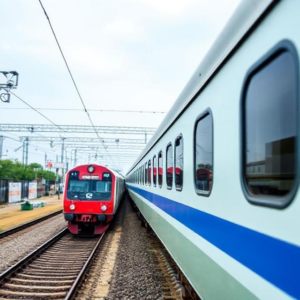Railway modernization projects in India are efforts to upgrade and improve the infrastructure, technology, and services of the Indian Railways to make it more efficient, comfortable, and safe. These projects aim to meet the growing demands of passengers, improve freight transport, and enhance the overall railway experience. Here’s an easy-to-understand overview of these projects:

1. Introduction of High-Speed Trains
- Vande Bharat Express (Train 18): This is a semi-high-speed, self-propelled train that was introduced in 2019. It is one of the fastest trains in India, with speeds of up to 160 km/h (100 mph). The Vande Bharat Express is designed to offer better comfort, modern amenities, and faster travel times compared to regular trains.
- Mumbai-Ahmedabad Bullet Train: India is planning its first high-speed bullet train project between Mumbai and Ahmedabad. It will run at speeds of 320 km/h (199 mph), reducing travel time between the two cities from 7 hours to just 2 hours. This will be a big step in modernizing the rail network.
2. Electrification of Railways
- Electric Trains: To reduce dependence on fossil fuels (coal), Indian Railways is working to electrify more and more of its railway tracks. By replacing diesel engines with electric ones, the trains will be more energy-efficient and environmentally friendly.
- 100% Electrification Target: Indian Railways has set a goal to electrify all its tracks by 2030. This will not only save fuel costs but also reduce air pollution.
3. Dedicated Freight Corridors
- Dedicated Freight Corridors (DFC): To improve the transportation of goods and reduce congestion, Indian Railways is building two dedicated freight corridors:
- Eastern DFC (from Kolkata to Delhi)
- Western DFC (from Mumbai to Delhi)
These corridors will be used exclusively for freight trains, which will make the movement of goods faster and more efficient. It will also help passenger trains run on time, as they won’t have to share tracks with freight trains.
4. Modernization of Railway Stations
- Smart Stations: Indian Railways is working on transforming old railway stations into smart stations. These stations will have modern facilities like:
- Digital ticketing systems
- Wi-Fi
- Improved waiting areas
- Clean and hygienic restrooms
- Modernized platforms with better accessibility
- Energy-efficient lighting and air-conditioning
The goal is to make railway stations more comfortable and user-friendly for passengers.
- Example: Habibganj Station in Madhya Pradesh has been revamped into a world-class smart station with modern amenities and infrastructure.
5. Modernization of Trains
- Tejas Express: The Tejas Express is a fully-equipped, luxury train with modern features like:
- Wi-Fi
- Onboard meals
- GPS tracking
- CCTV cameras for security
- Comfortable seats with more legroom It operates on various routes like Mumbai-Goa and Lucknow-Delhi.
- Duronto Express and Rajdhani Express: These trains are getting upgrades to provide faster, more comfortable services. They offer premium amenities and are faster than regular trains, reducing travel time on important routes.
6. Use of Technology in Railways
- Digital Ticketing & Reservation Systems: Indian Railways has embraced technology by introducing online ticket booking and reservation systems. The IRCTC (Indian Railway Catering and Tourism Corporation) website and mobile app allow passengers to book tickets from anywhere at any time.
- Train Tracking Systems: Indian Railways is implementing GPS-based tracking systems to allow passengers to track trains in real-time, helping them stay updated about delays or arrivals.
- Modern Signaling Systems: To ensure safety and speed, Indian Railways is adopting modern signaling systems like the Train Collision Avoidance System (TCAS). This system helps prevent accidents by automatically stopping trains if there is a danger of collision.
7. Upgrading Safety Features
- Automatic Train Protection (ATP): ATP is a system designed to prevent accidents. It automatically applies the brakes if the train is running too fast, or if the driver doesn’t respond to signals, reducing the chances of accidents.
- Fire-Resistant Coaches: New coaches are being built with fire-resistant materials to increase safety. These coaches are designed to be more durable and able to withstand higher temperatures in case of fire.
8. Bullet Train Technology and Innovation
- India is also working on adopting technology used by bullet trains in other countries, such as Japan. These trains are known for their speed, safety, and efficiency. The Mumbai-Ahmedabad Bullet Train project is a part of this initiative, and once completed, it will change how India views rail travel by introducing cutting-edge technology.
9. Green Initiatives
- Solar-Powered Trains: Indian Railways is installing solar panels on train stations and even on train roofs to generate clean, renewable energy. This helps reduce the carbon footprint and the railway’s reliance on non-renewable energy sources.
- Water Conservation and Waste Management: Stations and trains are being equipped with systems to conserve water and manage waste better. Bio-toilets have been introduced in many trains, which treat human waste without using water.
10. Smart Ticketing and Cashless Travel
- QR Code Ticketing: Passengers can now use QR codes to board trains instead of carrying paper tickets. This helps reduce the time spent at ticket counters and makes the process more efficient.
- Cashless Transactions: Indian Railways is encouraging cashless transactions through mobile payment apps and digital wallets for booking tickets, buying food, or paying for services at stations.
Conclusion
Railway modernization projects in India are transforming the country’s railway system into a more advanced, efficient, and passenger-friendly network. From high-speed trains to smart stations and the use of cutting-edge technology, these projects are setting the stage for a future where train travel in India is faster, safer, and more comfortable for everyone. The focus on sustainability, energy efficiency, and modernization will help Indian Railways remain one of the world’s largest and most influential rail networks.
Keywords: Railway modernization, Railway











